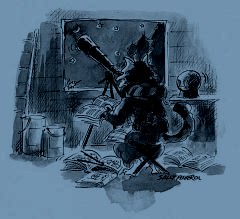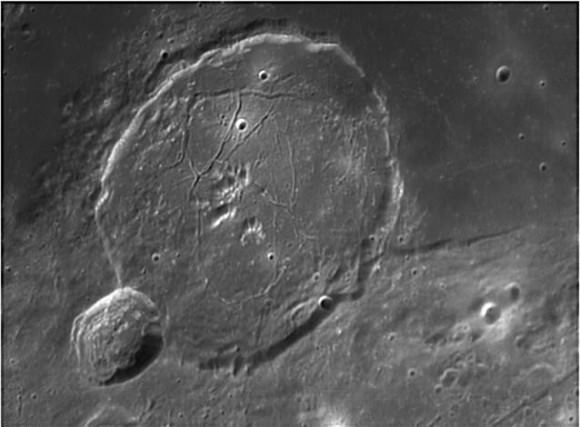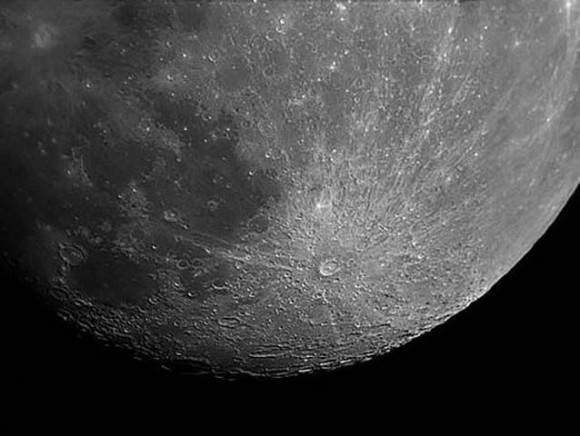Greetings, fellow SkyWatchers! For some parts of the world, baby? It’s cold outside… But those -23C temperatures haven’t kept some of us from chasing Comet C/2007 N3 Lulin and just knowing a few bright stars and having a pair of binoculars is all it takes for you to spot it, too! Or maybe you’d just like to spot the ISS? If skies are clear, why not spot the Moon and where SMART-1 did some imaging? Better yet, how about spotting a bright star to learn about – or a fantastic lunar impact crater? If you’re ready to see some “spots”, then grab your observing equipment and meet me outside…
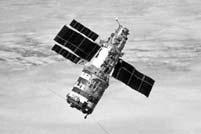 Friday, February 6, 2009 – This date marks the 1991 fiery return of the Soviet space station Salyut 7. Launched in 1982, electrical and maneuvering problems plagued the mission, but cosmonauts were able to stay on board for as long as 8 months before returning. Abandoned in 1986, equipment and supplies were transferred to the orbiting Mir. If you’d like to spot a space station like the ISS, check Heavens Above on how to get information for your area.
Friday, February 6, 2009 – This date marks the 1991 fiery return of the Soviet space station Salyut 7. Launched in 1982, electrical and maneuvering problems plagued the mission, but cosmonauts were able to stay on board for as long as 8 months before returning. Abandoned in 1986, equipment and supplies were transferred to the orbiting Mir. If you’d like to spot a space station like the ISS, check Heavens Above on how to get information for your area.
Return to the Moon tonight and explore the outstanding ring of crater Gassendi on the north shore of Mare Humorum. It’s over 3.6 billion years old, and about the size of the state of Arkansas! Roughly 110 kilometers in diameter and 2,010 meters deep, this ancient crater contains a central triple mountain peak and forms one of the most ‘‘perfect circles’’ on the Moon. Lava flows have eroded Gassendi’s south wall, and its floor is covered with ridges and rilles. Look for small crater Gassendi A on the northern rim. The northwestern section of the crater wall is slightly higher, saving it from the lava that formed Mare Humorum. Look carefully at the lower southern rim to find the gap where lava spilled over the walls. It’s only 200 meters above the surface, while other areas rise as much as 2,500 meters. The fact that some parts of the rim escaped the lava is what makes this an interesting area for science!
On January 13, 2006, the Advanced Moon Imaging Experiment (AMIE) on board ESA’s SMART-1 spacecraft imaged Gassendi from about 1,220 kilometers above the surface. Previous spectroscopic studies had shown that the central peaks might have experienced their own volcanic period – earlier than the event that filled the lower floors. These ancient highland rocks may one day give us significant insight into the thermal history of the Mare Humorum impact basin and the processes that formed Gassendi. Enjoy this ancient beauty!
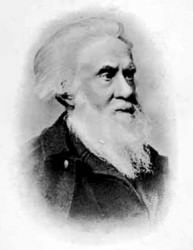 Saturday, February 7, 2009 – On this date in 1889, the Astronomical Society of the Pacific was born. In 1926 celebrated cosmonaut Konstantin Feoktistov, who flew Voskhod 1 and helped design Salyut and Mir, was born. Yet most noteworthy today is the 1824 birth of amateur astronomer William Huggins. By age 30, he’d built his own private observatory and through his studies made important contributions to astronomy. According to scientists Kirchoff and Bunsen, the chemical composition of minerals could be determined from their spectral signatures. The inquisitive Huggins began comparing mineral samples to the spectra of celestial objects. Although his experimental methods were crude by today’s standards, his calculations were perfect. Huggins proved the spectrum of the Orion Nebula was like that of a pure gaseous emission, while the spectrum of the Andromeda Nebula was similar to that of starlight—and this long before confirmation of its galactic nature! Huggins was also the first amateur to measure the radial velocities of stars from their spectral shifts. Although most people assume only professional scientists can make such measurements, many of today’s amateurs (unpaid, but not unskilled!) have measured spectra.
Saturday, February 7, 2009 – On this date in 1889, the Astronomical Society of the Pacific was born. In 1926 celebrated cosmonaut Konstantin Feoktistov, who flew Voskhod 1 and helped design Salyut and Mir, was born. Yet most noteworthy today is the 1824 birth of amateur astronomer William Huggins. By age 30, he’d built his own private observatory and through his studies made important contributions to astronomy. According to scientists Kirchoff and Bunsen, the chemical composition of minerals could be determined from their spectral signatures. The inquisitive Huggins began comparing mineral samples to the spectra of celestial objects. Although his experimental methods were crude by today’s standards, his calculations were perfect. Huggins proved the spectrum of the Orion Nebula was like that of a pure gaseous emission, while the spectrum of the Andromeda Nebula was similar to that of starlight—and this long before confirmation of its galactic nature! Huggins was also the first amateur to measure the radial velocities of stars from their spectral shifts. Although most people assume only professional scientists can make such measurements, many of today’s amateurs (unpaid, but not unskilled!) have measured spectra.
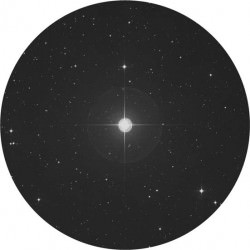 Tonight let’s look at a star whose radial velocity has been studied both professionally and personally – Kappa Orionis (RA 05 47 45 Dec -09 40 10). Named Saiph, it’s the often-overlooked eastern ‘‘foot’’ of Orion. According to spectral analysis, this 722 light-year distant blue supergiant is moving away from us at 21 kilometers per second.
Tonight let’s look at a star whose radial velocity has been studied both professionally and personally – Kappa Orionis (RA 05 47 45 Dec -09 40 10). Named Saiph, it’s the often-overlooked eastern ‘‘foot’’ of Orion. According to spectral analysis, this 722 light-year distant blue supergiant is moving away from us at 21 kilometers per second.
Roughly the same type, size, and distance as Rigel, it looks far fainter. But why? Oddly enough, Saiph has an extremely high temperature, burning more than 1,500 K hotter. Near the point where helium fusion replaces hydrogen fusion, the majority of its variable light output is in the ultraviolet band. And as Huggins once said: ‘‘It is remarkable that the elements diffused through the host of stars are some of the most closely connected with the living organisms of our globe.’’
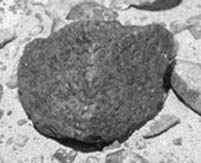 Sunday, February 8, 2009 – On this date in 2001, the Sayh al Uhaymir 094 Mars Meteorite was discovered. Some space-born debris from Martian impact craters is eventually captured by Earth’s gravity. The surviving meteorites can be identified by their mineral composition, as well as from tiny gas deposits matching Viking lander samples of Mars’s atmosphere.
Sunday, February 8, 2009 – On this date in 2001, the Sayh al Uhaymir 094 Mars Meteorite was discovered. Some space-born debris from Martian impact craters is eventually captured by Earth’s gravity. The surviving meteorites can be identified by their mineral composition, as well as from tiny gas deposits matching Viking lander samples of Mars’s atmosphere.
Tonight, aim your optics toward the Moon and study an impact crater large enough to have blasted lunar material back to Earth. Its name is Tycho… Take one glance at the lunar Southern Hemisphere, and you can’t miss the dazzling display of 85-kilometer-wide Tycho, and its brilliant splash ray pattern. Perhaps 100 million years ago a comet, an asteroid, or a large meteorite impacted the Moon, flinging debris far and wide. One of Tycho’s ejecta paths (rays) crosses the Apollo 17 landing site almost 2,000 kilometers away, where it caused a landslide, revealing deeper materials. Shining like a beacon in Tycho’s center is a mountain peak originating from below the surface crust. The crater floor is lumpy and the rim broken by the force of the impact.
Could a collision like Tycho’s create Earth-bound meteoroids? Indeed, you may have walked on one unaware! The first confirmed lunar meteorite was found in 1979 in Antarctica, but it was many years before its true identity was known. Confirmation required comparison of its chemical composition to that of Apollo lunar samples. To date, only around 40 confirmed lunar meteorites are known, but as many as one in every thousand may have originated from our nearest neighbor. Noble gas measurements show some of these materials may have left the lunar surface up to 20 million years ago, but most are around 100,000 years old. They might resemble terrestrial rocks, but ones with their chemical composition are found only on the Moon. Have a look at Tycho and imagine the power that sculpted this mighty crater!
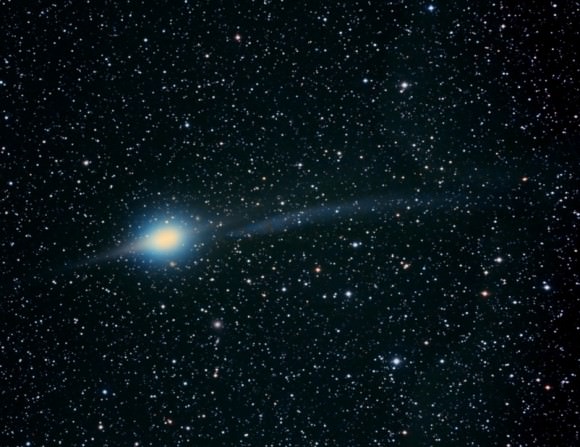
For those who don’t mind getting up early, be sure to keep your eye on the mighty Comet C/2007 N3 Lulin! If you have trouble reading star charts – don’t worry. It’s a whole lot easier to find in binoculars than you might think. All you need to do is just know how to identify a few bright stars! If you live in the northern hemisphere, about an hour (even two if you have a clear skyline) go out and identify Scorpius rising to the southeast – or Virgo high in the south, if you prefer. (For other locations, simply follow the ecliptic plane.) Between the two constellations you’ll see bright optical double star Alpha Librae – Zubenelgenubi. You’ll know if you have the right star because it will appear as two close stars in your binoculars. As of the morning of February 6th, Comet Lulin appeared in the 2 o’clock position with Zubenelgenubi in the field and it’s slowly headed towards Spica – Alpha Virginis. Remember as each successive day passes to start at Zubenelgenubi (it’s about a hand span east-southeast of Spica) and move the binoculars slowly towards Spica until you spot it. It will appear as a small, faint fuzzy in 5X30 binoculars and elongated in 16X60s. Even with telescopes as small as 114mm in aperture, it’s easy to make out that signature tail! Don’t wait too long to capture it, though… Because it won’t be long until the Moon is going to interfere and make this 7th magnitude comet far more difficult to spot.
Until next week? Ask for the Moon, but keep on reaching for the stars! You could just catch a comet…
This week’s awesome images are: Salyut (historical image-NASA), Gassendi (credit-Wes Higgins), William Huggins (historical image), Kappa Orionis: Saiph (credit-Palomar Observatory, courtesy of Caltech), Mars meteorite (historical image), Tycho (credit-Roger Warner) and Comet Lulin (credit-Joe Brimacombe). Thank you for sharing!

